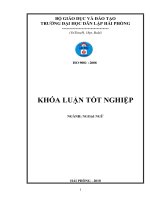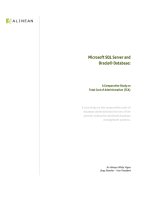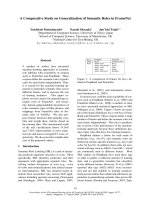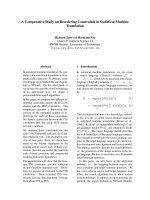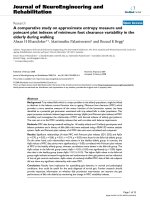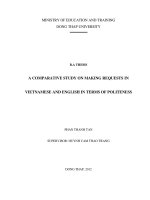A comparative study on Conversational Implicatures used in political electronic English and Vietnamese articles on Vietnam - China island disputes
Bạn đang xem bản rút gọn của tài liệu. Xem và tải ngay bản đầy đủ của tài liệu tại đây (783.66 KB, 73 trang )
VIETNAM NATIONAL UNIVERSITY, HANOI
UNIVERSITY OF LANGUAGES AND INTERNATIONAL STUDIES
FACULTY OF POST- GRADUATE STUDIES
********************
A COMPARATIVE STUDY ON CONVERSATIONAL IMPLICATURES
USED IN SOME POLITICAL ENGLISH AND VIETNAMESE
ELECTRONIC NEWSPAPER ARTICLES ON THE EVENTS RELATED
TO VIETNAM-CHINA ISLAND DISPUTE
ợc sử dụ
(
ị về các sự kiệ l
a
-
q a
c trên m t s
ế
a
ệ
ện tử Tiếng Anh và Tiếng Việt)
M.A. MINOR PROGRAMME THESIS
Field: English linguistics
Code: 60220201
HANOI - 2017
VIETNAM NATIONAL UNIVERSITY, HANOI
UNIVERSITY OF LANGUAGES AND INTERNATIONAL STUDIES
FACULTY OF POST- GRADUATE STUDIES
********************
A COMPARATIVE STUDY ON CONVERSATIONAL IMPLICATURES
USED IN SOME POLITICAL ENGLISH AND VIETNAMESE
ELECTRONIC NEWSPAPER ARTICLES ON THE EVENTS RELATED
TO VIETNAM-CHINA ISLAND DISPUTE
ợc sử dụ
(
ị về các sự kiệ l
a
-
ts
q a
ế
a
ện tử Tiếng Anh và Tiếng Việt)
M.A. MINOR PROGRAMME THESIS
Field: English Linguistics
Code: 60220201
Supervisor: Dr.
ệ
ị
HANOI - 2017
a
DECLARATION
I certify that this minor thesis entitled “A comparative study on
Conversational Implicatures used in political electronic English and Vietnamese
articles on Vietnam - China island disputes” submitted in partial fulfillment of
the requirements for the degree of Master of Arts is the result of my work, except
otherwise acknowledge and that this minor thesis and any part of the same has
not been submitted for a higher degree to any other university or institution.
Hanoi, January 2017
Signature
V Thị Mai Ph ơng
i
ACKNOWLEDGEMENTS
After the past two years I have received the support and encouragement
from many individuals to accomplish this research. Therefore, I hereby would
like to express my profound gratitude to all of them.
Above all, I would like to express my deepest appreciation to my
supervisor, Doctor Do Thi Thanh Ha for all of her invaluable inspiration,
assistance, critique, sincere guidance and encouragement as I was working on my
study.
Besides, I am grateful to all lectures and staff of Faculty of Postgraduate
Studies, University of Languages and International Studies for their valuable
lessons and precious help. Thanks to them, I could get the essential materials for
my paper.
Finally, my sincere thanks go to my family and my friends who always
stand by me and support me when I was doing the research. Without their
encouragement, I would not have been able to complete this thesis.
ii
ABSTRACT
The topic on politics has attracted many researchers in all fields and
linguistics is not an exception, specially, the announcements of official
politicians and commentary, judgments of the specialists informed on the media.
Nowadays, the political events of the global countries have been updated almost
immediately by the assistance of internet. Electronic newspapers play a very
important role and grab much power in the modern life.
In the world recently, the political movements in Asia especially between
Vietnam and China island disputes have wasted the inks and papers of worldwide
newspapers. The study was conducted to compare the use maxim violation to
generate conversational implicature of English and Vietnamese electronic
newspapers on the coverage hottest events on Vietnam - China island disputes in
the period from 2011 to 2015. The analysis includes examining the methods of
generating implicature which consists of violating four conversational maxims
based on Relevance Theory of Grice. Based on the findings, it is concluded that
both English and Vietnamese newspapers showed their creativity in using
different devices to violate the maxims to generate conversational implicatures.
In addition, the two types of newspapers share a lot of similarities. Specially, the
quality maxim is violated the most frequency among four maxims. Besides, the
study assumes that the language of politics and journalism affect deeply on the
applying of maxim violation to generate conversational implicatures. The study
also contributes a new finding that conversational implicatures and Relevance
theory of Grice both work effectively in not only oral conversations but also in
indirect conversation such as in written texts whose speakers/ hearers interaction
are writers/ readers interaction to convey the meaning and messages.
iii
TABLE OF CONTENTS
Declaration ...........................................................................................................i
Acknowledgements ...........................................................................................ii
Abstract ............................................................................................................ iii
Table of contents ................................................................................................ iv
List of abbreviations ........................................................................................... vi
List of tables ......................................................................................................vii
PART A: INTRODUCTION ............................................................................ 1
1. Rationale of the studies.................................................................................... 1
2. Research questions .......................................................................................... 1
3. Aims of study .................................................................................................. 2
4. Scope of the study ........................................................................................... 2
5. Methods of the study ....................................................................................... 2
6. Organization of the study ................................................................................. 3
PART B: DEVELOPMENT ............................................................................. 4
CHAPTER 1: LITERATURE REVIEW ......................................................... 4
1.1. Theories on conversational implicature ........................................................ 4
1.1.1. Implicature and Co-operation ............................................................... 4
1.1.2. Conversational and Conventional Implicatures ..................................... 5
1.1.3. Violating implicature ............................................................................. 6
1.2. Review of related study ................................................................................ 9
1.3. Review of Vietnam - China island disputes in the period of time from 2011
to 2015 ............................................................................................................. 11
CHAPTER 2: METHODS AND PROCEDURES ......................................... 15
2.1. Data collection methods ............................................................................. 15
2.2. Data source ................................................................................................. 16
2.3 Data analysis procedure ............................................................................... 24
2.3.1 Data reduction .................................. ...................................................... 25
2.3.2 Data analysis ............................................................................................ 25
CHAPTER 3: RESULTS AND DISCUSSION ............................................. 27
3.1. Conversational implicatures in Vietnamese electronic magazines .............. 27
iv
3.1.1. Conversational implicatures generated by violating the maxim of quality in
English magazine articles ................................................................................. 30
3.1.2. Conversational implicatures generated by violating the maxim of quantity
in English magazine articles ............................................................................. 31
3.1.3. Conversational implicatures generated by violating the maxim of relation
in English magazine articles .................................................................... 33
3.1.4. Conversational implicatures generated by violating the maxim of manner
in English magazine articles ............................................................................. 34
3.2. Conversational implicatures in English electronic magazines .................... 34
3.2.1. Conversational implicatures generated by violating the maxim of quality in
English magazine articles ................................................................................. 36
3.2.2. Conversational implicatures generated by violating the maxim of quantity
in English magazine articles ............................................................................. 37
3.2.3Conversational implicatures generated by violating the maxim of relation in
English magazine articles ................................................................................. 38
3.2.4Conversational implicatures generated by violating the maxim of manner in
English magazine articles .................................................................................. 39
3.3 Comparison between English and Vietnamese electronic newspaper articles
in English magazine articles .............................................................................. 39
3.3.1 Similarities .............................................................................................. 40
3.3.2 Differences .............................................................................................. 43
PART C: CONCLUSION AND SUGGESTION .......................................... 44
1. Summary of findings .................................................................................... 44
2. Implications .................................................................................................. 46
3. Limitations of the study ................................................................................ 46
4. Suggestions .................................................................................................. 47
REFERENCES ............................................................................................... 48
APPENDIX ....................................................................................................... I
v
LIST OF ABBREVIATIONS
CP: Cooperative Principle
CNOOC: China National Offshore Oil Corp
CDA: Critical Discourse Analysis
US: United States
USA: United States of America
ASEAN: Association of South East Asian Nation
CI: Conversational Implicature
VN: Vietnam
CN: China
WEF: World Economic Forum
SCS: South China Sea
TV: Television
Ql: quality
Qt: quantity
Mn: manner
Rl: relation
vi
LIST OF TABLES
Table 1.2. Vietnam - China island dispute timeline .............................................. 9
Table 2.2. Data source ....................................................................................... 17
Table 2.3.2 Coding scheme................................................................................ 25
Table 3.1 Frequency of maxim violation in Vietnamese articles ........................ 28
Table 3.2 Frequency of maxim violation in English articles............................... 35
Table 3.3 Data comparative ............................................................................... 40
vii
PART A: INTRODUCTION
1. Rationale of the study
Nowadays, online newspapers have indisputably become one of the most
useful and convenient source of information. Along with the spread of internet,
online news is increasingly popular due to the availability and convenience they
provide. With internet and computer, the readers have a chance to get a great deal
of diverse online newspapers. Political news is always the hot area of information
that attracts readers‟ attention. Due to the fact that news are posted and updated
simultaneously to assure the accurate of the news, especially the news related to
politics. Such news need to express the truth. They are also governed by the state
power for the political purposes. Therefore, the writers have to use some kinds of
pragmatic devices that implicatures are the most common one. To reach to the
understanding between the writer and the receivers or readers, using implicatures
as a useful linguistic resource is a useful way. Realizing the importance and
significant of implicatures in newspaper article, this study is carried out to
investigate the use of implicature in transferring the information to in the
language of Vietnamese and English newspaper articles.
2. Research questions
Based on the background and the focus of the research, the writer
proposed three questions for this study, those are:
1)
What are the conversational maxims that are violated in the Vietnamese
electronic newspaper articles on Vietnam- China island disputes to generate
conversational implicatures?
2)
What are the conversational maxims that are violated in the English
electronic newspaper articles on Vietnam- China island disputes to generate
conversational implicatures?
3)
What are the similarities and differences on adopting conversational
maxim violation to generate conversational implicatures between English and
Vietnamese electronic newspaper articles on Vietnam - China island disputes?
1
3. Aims of the study
The study deals with the exploitation of conversational implicatures in the
Vietnamese and English political newspaper articles. Therefore, the study is
aimed specifically:
-
To identify the conversational implicatures which are generated and the
conversational maxims which are violated in the political Vietnamese electronic
newspaper article on Vietnam- China island disputes.
-
To identify the conversational implicature which are generated and the
conversational maxims which are violated in the political English electronic
newspaper article on Vietnam- China island disputes.
-
To compare the similarity and differences of adopting implicatures in
English and Vietnamese electronic newspapers on Vietnam - China island
disputes.
4. Scope of the study
The study focuses on analyzing political articles in the press, not on
television or radio or any other media. The Vietnam-China island disputes lasted
from a long time before. However, due to the limit of time, this research is only
concerned with the main events in the time from 2011 to 2014. The newspapers
selected are doisongphapluat.com, vietnamnet.vn, vnexpress.net, dantri.com and
three other English popular and reputed ones - cnn.com, reuters.com and
bbc.com. Those newspapers are chosen for the reason that they update and
announce the official information from the government. Moreover, they are the
voice of the national law with high reliability and accuracy. Therefore, the data
collected are reliable to all readers.
5. Methods of the study
The study is an attempt to carry out an analysis of English and Vietnamese
newspaper articles on some of the most important events of Vietnam-China
island disputes in terms of implicatures. Specially, it focuses on how implicatures
is formed to convey the information about the island disputes between the two
2
countries. The research applies the theory of implicatures and cooperative
principle which are proposed by Grice to identify the forming process of
conversational implicatures.
The study used descriptive qualitative approach and content analysis as
the research design. One can undertake qualitative in a natural phenomena where
the writer works as the primary instrument of data collection that compiles
words, analyzes then inductively, concerns with the meaning of participants, and
describes an expressive language processes (Creswell, 1998). In this case, the
writer collected the whole data related to sentences in electronic newspaper
articles. For a further description of the methods of the study, see chapter 3.
6. Organization of the study
This study consists of three main parts: Introduction, Development and
Conclusion.
Part A: Introduction presents the rationale, scope, aims and methods of the study
Part B: Development: in this part, three chapters are present.
Chapter 1: Literature Review deals with the theoretical framework relevant to the
topic.
Chapter 2: Methods and Procedure gives detailed description of data collection
method and analysis procedure.
Chapter 3: Results and Discussion of the results constitutes the main part of the
study. This part represents the results from the analysis on the utilization on
conversational implicatures in the English and Vietnamese newspaper articles
and discusses the findings.
Part C: Conclusion and Suggestion summarizes the findings of the study with
regard to the results of conversational implicature investigated some limitations,
implications and suggestions for further research.
3
PART B: DEVELOPMENT
CHAPTER 1: LITERATURE REVIEW
\
1.1. Theories on conversational implicatures
1.1.1. Implicatures and Co-operation
Up to now, there are some definitions of implicatures proposed by
scholars and linguists. Amongst them was Grice, who may be said to introduce
the term of first time in his William James lectures in 1967. He defined
implicatures as “a notion which is not explicitly stated but inferable from the
conventional meaning of some linguistic unit in an utterance and taken to be
communicated”. According to Thomas (1995), Grice‟s theory is “an attempt at
explaining how a hearer gets from what is said to what is meant, from the level of
what you expressed meaning to the level of implied meaning.” To help the
readers understand implicatures more, he gave an example of implicatures as
stated below:
“We must remember your telephone bill”, she said, hinting that Louis has talked
long enough. “Good bye”, said Louis ringing off. It takes the rich to remind one
of the bills, she though.
In the example, we can see that when the speaker utters the words “We
must remember your telephone bill”, she is implying that she wants to close the
conversation. It is necessary to distinguish between implying and inferring, or
implicature and inference. Implicatures are generated intentionally by the speaker
and may be understood by the hearer whereas inference is produced by the hearer
deducing something from evidence.
Levinson (1983:97) mentions that the projection of the concept of
implicatures in recent work in pragmatics is due to a number of sources. First,
implicatures stand as a paradigmatic example of the nature and power of
pragmatic explanations of linguistic phenomena. Second, implicatures provide
some explicit account of how it is possible to mean more than what is actually
4
said, i.e. more than what is literally expressed by the conventional senses of the
linguistic expression uttered.
Therefore, in the conversation, the speaker and the hearer co-operate with
each other, in other words, they follow the cooperative principles that Grice has
described in term of four categories of special cases, which is called “Maxims”.
These maxims can briefly be characterized in modified forms below:
1)
Maxim of Quantity: Be brief. Make your contribution as informative as
required and no more.
2)
Maxim of Quality: Be true. Do not say what you believe to be false and do
not say that for which you lack adequate evidence.
3)
Maxim of Relation: Be relevant
4)
Maxim of Manner: Be clear. Avoid obscurity and ambiguity.
It is suggested that the inferences arise based on the observation of four
mentioned conversation maxims. With the implicatures in which speakers
deliberately choose to flout one of the maxims, we call them flouting
implicatures.
1.1.2. Conversational and Conventional Implicatures
Thomas (1995:58) stated “To imply is to hint, suggest or convey some
meaning indirectly by means of language” (Thomas 1995: 58). He indicates that
Grice distinguishes between two kinds of implicatures: conversational
implicatures and conventional implicatures.
Conventional implicatures which convey the same extra meaning
regardless of context and is always lexicalized. Conventional implicatures are
carried by a restricted number of words: but, even, therefore, yet.
Grice gives the following convincing examples:
He is poor but honest.
This is an utterance stating that honesty appears contrary to expectations
in relation to financial under privileges.
John is an Englishman therefore he is brave.
5
And this is an utterance which triggers entailment built on the
argumentative of reaching a conclusion based on a set of premises:
Premise 1: All Englishmen are brave.
Premise 2: John is an Englishman,
Conclusion: John is brave
Conversational implicatures, which convey different meanings according
to different contexts, i.e. are calculated afresh each time the Speaker and the
Hearer interacts. Take the following example:
A: Is that scotch over there?
B: Help yourself.
A‟s utterance is literally a request for information (on the nature of the
liquor), yet B interprets it as a request for a drink. Nothing in the literal meaning
of A‟s utterance could lead B to that interpretation, which can only be derived by
means of conversational implicature.
1.1.3. Violating implicature
Faced with a speaker‟s non-observance of a maxim, a competent hearer
will draw one of several possible conclusions:
a) The speaker is openly „opting out‟ from the operation of the maxim and is
unwilling to abide by the CP.
b) The speaker is deliberately and secretly subverting the maxim and the CP,
usually for some self-serving purpose. This constitutes an instance of maxim
violation.
c) The speaker means to observe the CP, but fails to fulfill a particular maxim
through ineptitude. For example, he may ineptly use words too technical for the
audience and occasion, thus inadvertently non-observing the Maxim of Manner.
This is an instance of maxim infringement.
d) The speaker presumably means to observe the CP, and yet s/he is blatantly not
observing a maxim; if he is not inept, s/he must mean something additional to
what s/he is saying.
6
For example, when asked what she thinks of a new restaurant, a woman
who replied: „They have handsome carpets.‟ would appear to be flouting the first
Maxim of Quality. If there is no reason that she means not to be observing the CP
and that she is not inept either, then her remark must mean something other than
what it literally asserts - for example, that the food they serve is not the best in
town. When non-observance of a maxim is deliberate and intended to be
recognized as deliberate, this is a case of Maxim Flouting (Hancher, 1978).
Paradoxically enough, more often than not, people fail to observe the
maxims, be it deliberately or accidentally. There are five major ways of failing to
observe a maxim: flouting, violating, infringing, opting out and suspending.
Violation is defined as the unostentatious or „quiet‟ non-observance of a
maxim. A speaker who violates a maxim „will be liable to mislead‟ (Grice, 1975:
49).
Violating a maxim is quite the opposite of flouting a maxim. Violating a
maxim rather prevents or at least discourages the Hearer from seeking for
implicatures and rather encourages their taking utterances at face value. These
following examples were cited from Arif Suryo Priyatmojo; in his article namely
Indonesia Political Language (page 4-6).
Violation of the Maxim of Quantity
Politicians often violate this maxim by giving too much information as the
following political language discourses.
“Of course, we will discuss over some topics,” (Megawati, Jakarta post 30
April 2009)
This utterance does not give sufficient information since there is no
information that readers can get from it.
Violation of the Maxim of Quality
"The electricity crisis is a consequence of the rapid growth, but I think
that's not a valid excuse” (Kalla, Jakarta Post, 28 April 2009).
7
The utterance does not give sufficient information because the first and
the second clause are not related. The second clause did not support the first
clause for he was not quite sure about his information. It is posibble that he was
lack of evidence.
Violation of the maxim of relation
“Golkar has been providing high quality entertainment in every general
election since the reform era,” (Jeffri Winter, The Jakarta Post 29 April 2009).
The utterance violates the maxim of relevance because the addresser
didn‟t give the relevant information. The utterance also failed to address the goal
of the utterances. The readers were confused in analyzing it because it didn‟t
have any relation with the topic discussed.
1.2. Review of related studies
Conversational implicatures (C.I) is a type of indirect communication,
first described by the English language philosopher Herberb Paul Grice. He
proposes that in a normal conversation, speakers and listeners share a cooperative
principle. When a speaker appears not to follow the maxims, he implies a
function different the literal meaning of form. The speakers assume that the
hearers know that their words should not be taken at face value and that they can
infer the implicit meaning. In the electronic newspapers and other political
editors, conversational implicatures are used to get the understanding between
the writer and the readers. By using CI, the writer can express their own
viewpoint as well as their feeling on the discussed issues. Grice‟ theory has been
the foundation of many studies about implicatures in linguistics. In a study of
Wakhana Putri namely An analysis of implicatures as found in transcript of
interview between Barack Obama and Hisyam Melhem from Al-Arabiya TV, the
author has found that, implicatures may mostly occur in political conversations
and speeches. In addition, most of political utterances imply meaning. Politicians
tend to break the rules of cooperative principles and create conversational
implicatures. As in an interview, the politician may perform interestingly in front
8
of the audience and the interviewer because he or she wants to catch the people‟s
interest about what he or she talks. In this study, by studying the implicatures
used in the interview of the two presidents, the author assumed that during the
process of interview Hisyam Melhem as the interviewer expects the needed
response from Obama. It fulfils the cooperative principle. The result of analysis
shows that Obama violates all of the maxims and this causes the occurrence of
implicature and precisely, he violates Grice‟s cooperative principle. Moreover,
Obama‟s reasons using implicature during the interview is that he wants to show
the power of the United State. However, the statements are bias to one side only.
Nevertheless, he wants to be careful with what he says in commending the point
of view about the track between Palestinians and Israeli.
The multidimensionality of political discourse has attracted a great deal of
attention from discourse analysis. Studies vary from the role of evasion in
political talk (Harris, 1991), the relationship between politics, the government,
and the media (Fairclough, 1998, 2000; van Dijk, 1998), ideology and political
discourse (Hudson, 1978), political language in general (Wodak, 1989) have all
been given some attention. In addition, many studies take CDA‟s perspective to
analyze textual data made by different political leaders from different political
background, ages, gender, etc, in order to undertake a detailed investigation of
the way political speakers negotiate and maintain face work, show their national
power when interacting with each other in such contexts. In the studies about
political discourse in diplomatic relationship such as speeches of president
Obama (Jurai), political press conferences (Aditi, 2006, Critical discourse
analysis and political press conference), political editors (Hussain), political
interviews (Dr. Eba‟, Analyzing Political Discourse: Towards a Pragmatic
Approach), researchers found that politicians mostly rely on pragmatic strategies
to grapple with the conflict between being uncooperative and truthful. It is
apparent that political discourse revolves around being manipulative and hedgy,
giving less information about the truth of things. A politician actually hides
9
himself behind these skills so as not to attach himself to any kind of commitment.
He may use certain pragmatic skills to attack other rival politician's face in order
to improve his; or simply to simulate the feelings of the population and get them
to believe in him or drive them to follow his beliefs. According to Wodak (2007:
203) such pragmatic devices as implicatures can be analyzed in their multiple
functions in political discourse where they frequently serve certain goals.
The applying implicatures in political text has proved a fact that there is a
strict relationship between language, political ideology and power relations.
Aditi‟s study gave a closer look at diplomatic talk to communicate political
differences in a positive way to smooth out socio-political and ideological
discrepancies that often divide prominent political figures. Taking a critical
discourse analysis (CDA) perspective, this article analyses textual data from
press conferences involving the former Chinese President Jiang Zemin and the
US President George W. Bush, who come from different ideological
backgrounds, also sharing differences in other dimensions such as age,
experience, economic status, socio-political influence and political objectives.
The findings reveal three major themes: positivity for the reinforcement of
mutual trust, respect and progress; influence and power for subtle persuasion; and
evasion to hedge or avoid responses to probing and inconvenient questions from
the media.
Mostly, the studies on politics collect data from politician speeches,
interviews, conferences and on different media channels. This work uses internet
newspapers as a source of information. The articles are collected from popular
and reputed electronic newspapers. From the studying, the writer targets on
exploiting the use of conversational implicatures in the studied articles. The study
hopes to draw out the reasons how and why implicatures are used so often in
political texts. The analyzing process focuses on the utilization of conversational
implicatures, the features and hidden ideology of each newspaper on the events
of Vietnam - China island disputes.
10
1.3. Review of Vietnam - China island disputes in the period of time from
2011 to 2015
The East Sea is a semi-enclosed sea in the Pacific Ocean, covering an area
of over 3.5 million sq. km. It is bordered by nine coastal countries, namely
Vietnam, China, the Philippines, Malaysia, Brunei, Indonesia, Thailand,
Cambodia and Singapore. It is abundant in natural resources, especially oil, gas
and marine resources. Recently, data suggest that the sea has huge reserves of
natural hydrate.
The sea is the second busiest maritime route in the world after the
Mediterranean route, with 150 - 200 large-tonnage ships passing through its
waters every day. Imports and exports essential for such major economies as
China, Japan, the Republic of Korea, Chinese Taiwan and Hong Kong, depend
largely on this shipping route. Militarily, the East Sea is where naval fleets from
many countries both inside and outside the region operate.
All these factors have led to an inevitable and obvious situation that in the
East Sea the interests of many countries are closely intertwined at different
levels. Peace and stability in the East Sea directly affect peace and stability in the
region and the world. China‟s recent aggressive acts in the East Sea has pushed
escalation of tensions in the area and sparked concern that the area is becoming a
flashpoint with global consequences.
The Hoang Sa (Paracel) and Truong Sa (Spratly) archipelagos consist of a
series of tiny coral reefs and banks in the middle of the East Sea. At present,
these two archipelagos are at the center of complicated disputes between several
countries bordering the East Sea. The dispute between Vietnam and China is a
dispute over territory and sovereignty over these two islands. China‟s claims on
U-shaped line were the first case mentioned. China claims by far the largest
portion of territory - an area defined by the so-called "nine-dash line" which
stretches hundreds of miles south and east from its most southerly province of
11
Hainan. In the next step, China did illegal and aggressive acts in the East Sea.
After implementing the closed door policy for a long time, this country began
eyeing and encroaching into the East Sea. The process has happened as in the
table below:
Table 1.2. Vietnam - China island dispute timeline
Year
Event
1909
China began to occupy Hoang Sa (Paracel) Archipelago. This
nation continued its unruly hostility by drawing the U-shaped line in
1946, which covers around 80 percent of the East Sea. However
until May 2009 this line was public as China occupied eastern
islands in Hoang Sa Archipelago and Ba Binh Island in Truong Sa
(Spratly) Archipelago.
1956
The People‟s Republic of China occupied the eastern part of Hoang
Sa while Taiwan held Ba Binh Island in Truong Sa.
Two years later, the whole globe shocked with the official claim of
China on its sovereignty over Hoang Sa and Truong Sa.
1974
The western part of Hoang Sa was seized by China. Some other
islands in Truong Sa were gradually occupied in 1988, remarkably
Vanh Khan Island of Truong Sa in 1995.
1992
China stipulated unreasonable that the East Sea belongs to the
territorial waters of its Hainan province
1999
Vietnam and related countries have strongly protested China‟s
groundless and illegal U-shape line map when this map officially
submitted to the United Nations. China claims sovereignty over the
whole Hoang Sa Archipelago. Hoang Sa and the adjacent waters
were considered as its natural territory. It also claims sovereignty
over the entire Truong Sa Archipelago and its adjacent waters, but
admits to have disputes.
2011
China has been taking more aggressive and provoking acts in the
12
East Sea, including encroaching Vietnam‟s territories and cut the
cables of Vietnam‟s sea surveillance and oil exploration ships
named Viking 2 and Binh Minh 2. This country also issued ban on
fishing in the East Sea, covering the traditional fishing ground of
Vietnam.
6- 2012
The information about China‟s establishment of the so-called
"Sansha" city, which includes the island district of Truong Sa
(Spratly) of Khanh Hoa province, Vietnam and the Hoang Sa
(Paracels) island district of Da Nang, Vietnam was released. China
announced the opening of international bids for 9 oil and gas lot
within Vietnam‟s exclusive economic zone and Vietnam‟s
continental shelf.
8/2012
China again opened international bid for the oil and gas block
65/12, seriously violating Vietnam's sovereignty over the Paracel
Islands. The nine oil and gas lots that the CNOOC opened
international bids for are entirely in the exclusive economic zone of
200 nautical miles and the continental shelf of Vietnam.
10/2012 China held a flag raising ceremony to mark its National Day on Phu
Lam Island in the Hoang Sa archipelago.
the Chinese navy‟s Nanhai Fleet held an exercise in the waters of
the Hoang Sa archipelago and five days later, China set up a
meteorological station in the so-called Sansha City
11/2012 China published a map of "Sansha," which includes the Hoang Sa
and Truong Sa archipelagos and the exclusive economic zone and
continental shelf of Vietnam.
3/2013
While Vietnam's Binh Minh 02 ship was conducting normal seismic
exploration in the exclusive economic zone and continental shelf of
Vietnam, two Chinese fishing vessels deliberately obstructed and
cut the ship‟s cable, regardless of the warning signal of functional
13
forces of Vietnam.
5/ 2014
China deployed the mobile HD-981 drilling rig in the exclusive
economic zone and continental shelf of Vietnam. The drilling rig is
escorted by many ships of the coast guard, the naval and fishery
surveillance forces of China. Chinese ships attacked vessels of the
law enforcement forces of Vietnam in Vietnam‟s waters. They also
rammed fishing ships of Vietnam. These acts have been strongly
objected by Vietnam and the international community.
This study focuses on the events in the period of time from 2011 to 2015.
In fact, this is the significant period in the timeline of arguments. For this reason,
the witer decided to study all the events related to Vietnam- China island disputes
in this period of time.
14
CHAPTER 2: METHODS AND PROCEDURE
2.1. Data collection methods
In conducting this research, the researcher employs the descriptive
qualitative method and content analysis. The researcher focuses on the activities
such as collecting data, classifying, analyzing, and drawing the conclusion.
Sutrisno Hadi (1983:30) states about descriptive method as a type of research,
which only collects, analyzes, and concludes the data without concluding them
commonly. Meanwhile, qualitative method is a research procedure, which
produces descriptive data in the form of written or oral words of people and
behavior, which can be observed (Bogdan & Taylor, in Moleong (2006: 5).The
research design was content analysis dealt with written texts. According to Ary et
al (2002) content analysis deals with analyzing and interpreting recorded material
within its own context such as public records and textbooks.
This study based on some following criteria for data selection:
First, news discourse is chosen specifically for analysis, thereby,
television news and radio news are not in the investigation. The data are collected
from official, reliable, popular and high-quality electronic newspaper. They are
included
phapluatdoisong.com,
vnexpress.net,
reuter.com,
dantri.com,
cnn.com,
nld.com.vn,
bbc.com.
Such
vietnamnet.vn,
newspaper
as
phapluatdoisong.com, vietnamnet.vn are either the official daily newspapers in
Vietnam or the voice of Vietnamese law and political power of Vietnam‟s
government. Whereas, reuter.com, cnn.com are trustworthy international
newspaper with high global edition published in 180 countries.
Second, all chosen articles from the newspapers have to contain
conversational maxim violation to generate implicature.
Third, researcher focuses merely on the articles related to the important
events in the Vietnam-China island disputes in the period of time from 2011 2015.
15
Forth, researcher must sort out the sentences or phrases hold
conversational implicatures and put them in the context. The researchers should
extract some neighbouring sentences if possible.
2.2. Data source
The sources of the data in this study are the articles covered the VietnamChina island disputes in both Vietnamese and English. On this issue, there are
such a considerable number of articles written in these electronic newspapers.
However, with the aim of the study to investigate the conversational
implicatures, the study examines 60 articles which are believed to contain
implicatures on the major events of Vietnam - China Island disputes focuses on
the certain period of time from 2012 to 2015.
The frequency of the articles about Vietnam - China island disputes in the
four newspapers are different. To assure an exactly finding for the similarity and
differences of Vietnamese and English newspaper articles, the number of chosen
articles are equal with 30 articles for each language.
Population is all of individuals to whom the facts which being got will be
generalized (Hadi, 1983). The population of this research was conversational
implicature found in the articles related to the subject of the study. There are a lot
of sentences that conversationally imply a meaning to the readers found in every
article. However, the researcher chooses them in random. The number of
conversational implicates chosen in the whole 60 articles in both language was
60, so the population was 60. The samples of this research are all the
conversational implicatures in the investigated articles.
16

